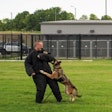How to deal with the scourge? Experts say first acknowledge the existence of gangs in your community, then recognize that police enforcement efforts are but one part of the answer.
While most experts acknowledge that gangs are present in every jurisdiction in America, almost every state has different laws pertaining to gangs, and some have different definitions of what actually constitutes a gang.
As of December, 1999, 26 states had gang-related definitions ranging from "street gangs," to "gangs," to "criminal street gangs," to "organized gangs."
Thirteen states had miscellaneous gang legislation, including Florida's "Street Terrorism Enforcement and Prevention Act of 1990," that was enacted due to "a mounting crisis caused by criminal street gangs whose members threaten and terrorize peaceful citizens and commit a multitude of crimes."
As each state struggles with its own ability to deal with the emerging and growing problem of gang violence, there has been no uniform, nationwide policy to assist communities that are either just beginning to face this problem or have become overwhelmed by it.
In the past few years, there has been a growing effort to involve law enforcement officials in a nationwide campaign to both exchange information and find ways to deal with gang problems in local communities.
James C. Howell, an adjunct researcher with the Institute for Intergovernmental Research for the National Youth Gang Center, in Tallahassee, Fla., has reported that gang crimes are increasing with more violent offenses, more serious injuries and the use of more lethal weapons. "Gang participation, drug trafficking, and violence occur together," he wrote, adding, "Because we lack a clear understanding of why and how youth gangs form, preventing their formation is problematic.
"Gangs emerge, grow, dissolve and disappear for reasons that are poorly understood. This lack of knowledge impedes efforts to prevent gang emergence, disrupt existing gangs and divert youth from them. Future youth gang research must address how gangs form, how existing gangs can be disrupted and how youth can be diverted from joining gangs," he wrote.
In a 1998 study commissioned by the Department of Justice, Office of Justice Programs, C. Ronald Huff agreed: "Gang members are much more likely than non-gang members to possess powerful and highly lethal weapons. The criminal behavior committed by gang members is extensive and significantly exceeds that committed by comparable at-risk but non-gang youths."
These findings certainly do not surprise police departments that have acknowledged gang problems in their communities. But according to Del. Wes Daily, Jr., president of the National Alliance of Gang Investigators Association, Inc., there are two types of police departments that now exist across the country.
"The difference is major," he explained. "There are those that look at the problem and say OK let's go get them, and those that say I don't see it."
In a 1997 statement before the Senate Committee on the Judiciary of the United States Senate, Steven R. Wiley, from the Federal Bureau of Investigations, stated, "Two of the basic obstacles in addressing gang activity in communities around the nation is the absence of a universal definition for gangs and the difficulty in documenting the nature and extent of gang-related criminal activity.
"While some communities acknowledge difficulties in dealing with the problem, they fail to concede that they have a gang problem until the gangs become firmly entrenched."
Daily said his organization is one of the few that reaches out nationwide. It consists of 16 individual gang associations and nine federal agencies, including The Bureau of Justice Assistance, The Bureau of Alcohol, Tobacco and Firearms, The Department of Justice, The Federal Bureau of Investigations, The Federal Bureau of Prisons, The National Youth Gang Center, The National Drug Intelligence Center, The Office of Juvenile Justice Delinquency Prevention, and The Office of National Drug Control.
Daily added that the members of the local groups are "cops that we work with. Some represent departments, but we are not about departments; we are about men and women - professionals that come together who recognize the problem.
"So, if a department is in denial, a law enforcement officer can still do his job. He still knows what to look for. They have the gang information they need- the graffiti, tattoos, tagging, colors and they can begin to do lawful arrests, based on that information."
Tackling the gang problem is a difficult and often complicated undertaking.
The U.S. Department of Justice, Bureau of Justice Assistance in May 1998, released "A Practical Guide to Addressing Community Gang Problems." In that publication, it concludes: "No universal strategy works to address all gang problems. The complexity of today's gangs suggests the need for a comprehensive, multifaceted effort that targets the reasons youth join gangs. Such an effort may involve three programmatic approaches: develop strategies to discourage gang membership; provide avenues for youth to drop out of gangs; and empower communities to solve problems associated with gangs through collaboration with law enforcement, parents, schools, youths, businesses, religious and social service organizations, local government officials, and other community groups in a comprehensive, systematic approach."
The study adds, "The diversity in gang types and in causes of gang formation and membership involves a broad range of social, political, family, educational, health, and other community factors. Such diversity suggests that prevention, intervention, and suppression activities should be designed to accommodate individual communities' unique characteristics, needs, gang populations, and specific gang-related harm. No universal strategy works to address all gang problems."
A Region Responds
In Nassau County, N.Y., like most jurisdictions across the country, the gang problem began slowly and many elected officials were reluctant to even admit to the presence of gangs. After numerous incidents, the Nassau County Police Department, in 1994, assigned a detective to monitor and gather gang intelligence. Then, in May 1998, as it became more apparent that a gang presence had taken hold in the area, an assistant chief was appointed by the county executive to lead what was described as a "gang intervention partnership."
The police department also assigned detectives to become part of a special group that gathered intelligence on gangs. Information then began to be exchanged within the department, but not on a formal, regulated basis. The intelligence gathered continued to show an increase in the number of gangs and violent activities, a trend that is not unusual in an area once gangs take hold.
It did indicate an immediate need for further actions.
"The initial incidents were either gang members committing quality-of-life crimes or acts of violence, involving the same gang," Nassau County First Precinct Sgt. John Carney told POLICE. The first precinct in the county contained some of the more concentrated areas of gang crimes.
As a result, the Problem Oriented Policing (POP) Unit began some of their own initiatives, including contacting the local schools and beginning programs with them. "We wanted them to know that just because they were inside a school, it was no safe haven. The schools talk to the police and the police talk to the schools," said Off. Mike Maloney, the gang coordinator for the precinct.
(It is interesting to note, that while the officers reported a great deal of cooperation with the school in their precinct, other precincts and jurisdictions on Long Island have also reported that schools have become fortresses and will not cooperate in any way with law enforcement. Often they do not even report crimes on their campus to the police.)
Within the first precinct, a trend was beginning to emerge that signaled a need for greater attention.
"A year ago we saw that the local groups were starting to follow the philosophy of the Bloods and the Crips. It became in vogue to take the national gang activities from the West Coast. They now took sides, one with the Crips and the others with several factions of the Bloods," said Sgt Carney.
The migration of these gangs was predictable. "New York City always had the Bloods and we had the Mara Salvatrucha (MS). Now we see Bloods and they see MS," said Officer Maloney.
There was also migration within the county. "A year ago we could say some communities had no gang activity at all. We can't say that anymore," Sgt. Carney said.
And so, in April 2000, a pilot program was formalized for the first precinct.
Pilot Program's Basics
Its foundation lay in the operational and community-based strategies already undertaken by aggressive officers who saw a problem and set out to do something about it.
The programs, called the "Gang and Gun Suppression Initiative," contained three components: intelligence, operations and school-community interactions.
The intelligence component consisted mainly of assessment and dissemination of gang information by the POP unit gang coordinator who reviewed all case reports, arrests and field interviews and collated it with information received from the precinct crime analysis and the detective squad. He also served as a liaison with other jurisdictions and agencies.
A geo-analysis based on the NasStat model, consisting of locations of suspected gang incidents, shootings, gun arrests, suspected gang houses and residences of suspected gang members, pinpointed the target areas for the gang and gun suppression initiative.
The operations component included training of all police officers and supervisors, officer safety courses, information sharing, "zero-tolerance" target areas, field interviews, at Tests in gang related incidents, investigation of all graffiti, intense patrols of schools, especially known gang recruitment areas, and intense patrols of parks. Desk officers would also be specially trained, be more aware of gang areas and number of officers on patrol in those areas. A specially trained gang unit was also initiated.
According to Insp. Anthony Rocco, "Collecting and analyzing data in gang related harm-specific categories, such as gang arrests, gun arrests, assault and other criminal incidents, using the first precinct NasStat model; examining target area calls for service; monitoring the presence of graffiti; and surveys of community opinions and perceived levels of fear can give a picture as to the viability of actions taken."
As Nassau County, like hundreds of police departments throughout the country, continues to struggle to control their growing gang problem, The USDOJ Office of Justice Programs recently released its 1999 Juvenile Offenders and Victims National Report. It concludes "gang problems now affect more jurisdictions than before, including rural and suburban areas. Information about gangs in the U.S. has increased markedly, but forming an accurate national picture remains difficult."
They explain that it is difficult to form a clear statistical picture of youth gangs for a variety of reasons, including the fact that estimating the volume of gang crimes is difficult because some jurisdictions do not keep separate statistics for gang-related crimes and some do for only certain kinds of incidents. They also confirm that the definition of "gang crime" varies from place-to-place, concluding that in some places it is member-defined, while in others it is motive-defined.
The Challenge Ahead
As jurisdictions continue - or even begin - to deal with gang problems, often gang members attempt to stay ahead of law enforcement by not showing their colors or flashing their signs. Many, when arrested, will not admit to gang membership. Identifying gang members will become more difficult, and potentially more dangerous for police officers.
In some cases, it appears they have their own media campaign, often touting that they are not "gangs" but organizations that help their youth. The media then aids in glamorizing these gang members, without the background or knowledge to realize the crimes and violence these members commit.
It is important to note that the first step in dealing with gangs is the acknowledgement of their presence in the community. Then, law enforcement must let it be known that it is not just a police problem; it is a community problem.
Gangs can take over a neighborhood, or they can be controlled. While there are many obstacles and barriers to effectively controlling them, with acceptance of the problem, and research and determination to control it, a solution can be found.
Shelly Feuer Domash is a free-lance writer based in New York and a longtime, regular contributor to POLICE. Her most recent article for us was "Shift Happenings," in April '00, a discussion of creative human resource deployment ideas in principle and practice.












